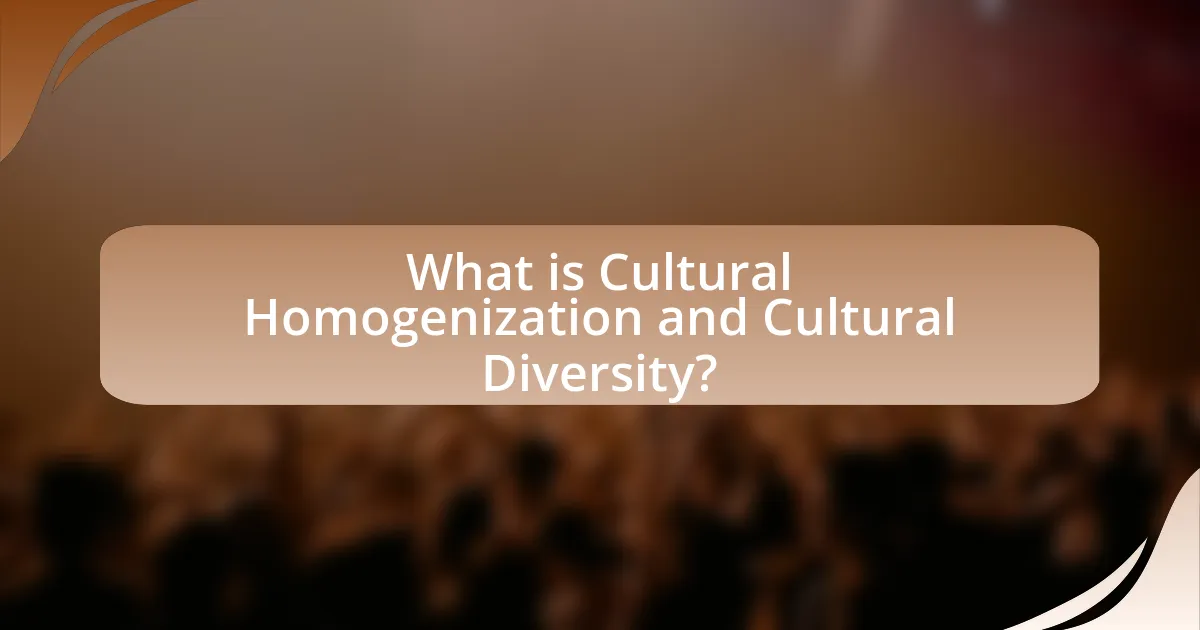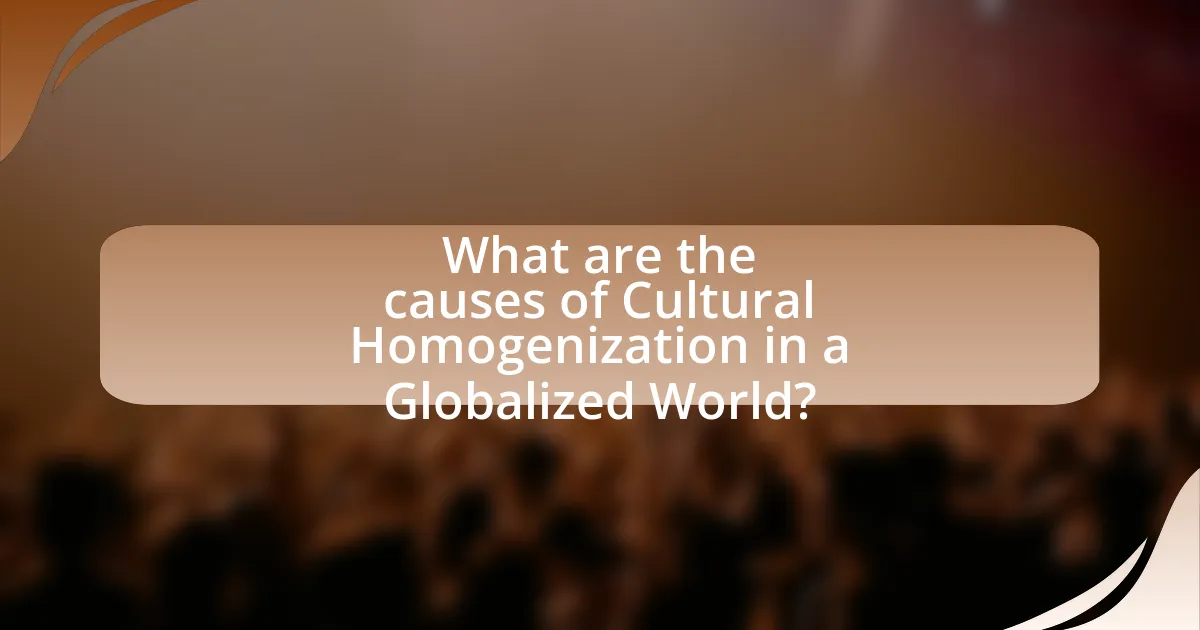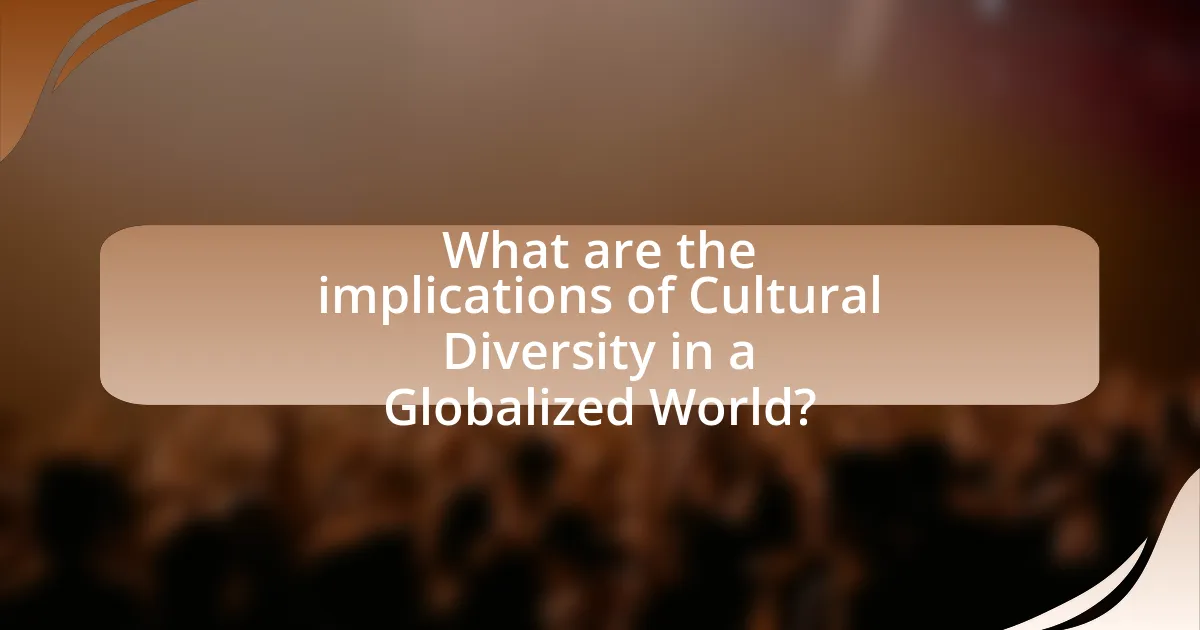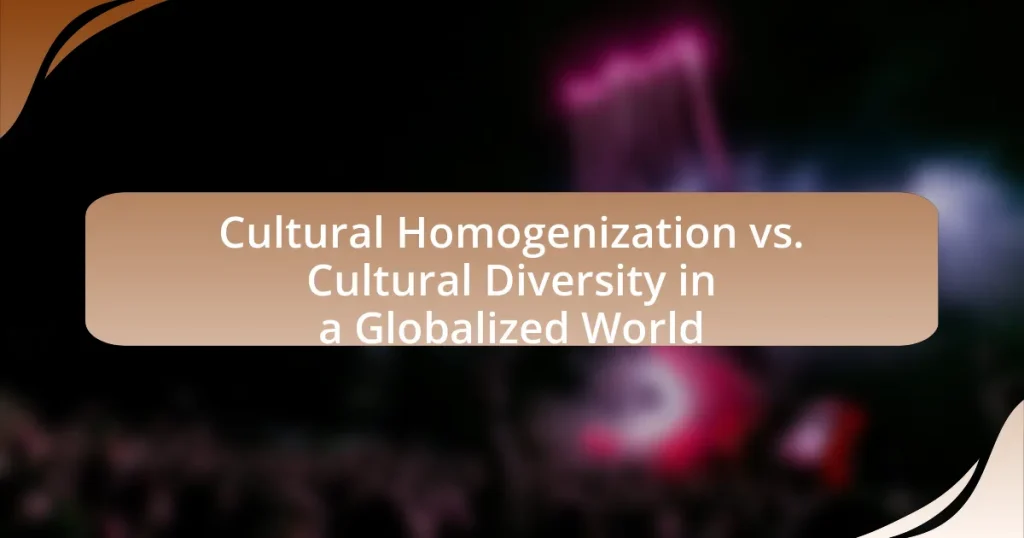Cultural homogenization and cultural diversity are two contrasting phenomena shaped by globalization. Cultural homogenization refers to the process where local cultures become increasingly similar, often dominated by Western influences, leading to the erosion of unique cultural identities. In contrast, cultural diversity highlights the coexistence of various cultural expressions, enriching societies through different languages, traditions, and beliefs. The article explores the implications of these concepts on global identity, societal development, and the challenges faced in preserving cultural diversity amidst the pressures of homogenization, while also discussing strategies to promote cultural richness in a globalized context.

What is Cultural Homogenization and Cultural Diversity?
Cultural homogenization refers to the process by which local cultures become increasingly similar to one another, often due to globalization and the influence of dominant cultures, such as Western culture. This phenomenon can lead to the erosion of unique cultural identities and practices as global brands, media, and technologies spread across different regions.
Cultural diversity, on the other hand, signifies the variety of cultural expressions and practices that exist within a society or between societies. It encompasses the differences in language, traditions, beliefs, and customs that contribute to the richness of human experience.
The interplay between cultural homogenization and cultural diversity is evident in global interactions, where the spread of a dominant culture can threaten local traditions while simultaneously fostering a greater awareness and appreciation for diverse cultural expressions. For instance, UNESCO recognizes the importance of cultural diversity in promoting sustainable development and social cohesion, highlighting that preserving cultural diversity is essential for maintaining the unique identities of communities worldwide.
How do Cultural Homogenization and Cultural Diversity differ?
Cultural homogenization and cultural diversity differ fundamentally in their impact on societal identity and expression. Cultural homogenization refers to the process where local cultures become increasingly similar due to globalization, often leading to the dominance of a single culture, such as Western culture, which can diminish local traditions and practices. In contrast, cultural diversity emphasizes the coexistence and appreciation of various cultural identities, promoting the idea that multiple cultures can thrive simultaneously, enriching societies with varied perspectives and practices. Evidence of cultural homogenization can be seen in the global prevalence of fast food chains and media, which often overshadow local cuisines and traditions, while cultural diversity is exemplified by multicultural societies that celebrate different festivals, languages, and customs, fostering a richer social fabric.
What are the defining characteristics of Cultural Homogenization?
Cultural homogenization is characterized by the diminishing diversity of cultural expressions and the emergence of a global culture that often prioritizes Western values and practices. This phenomenon is driven by globalization, where mass media, technology, and multinational corporations promote uniform cultural products, leading to shared experiences and lifestyles across different societies. For instance, the widespread consumption of Western media, such as Hollywood films and pop music, exemplifies how local cultures may adopt similar traits, resulting in a loss of unique cultural identities. Additionally, the prevalence of global brands, like McDonald’s and Coca-Cola, illustrates the standardization of consumer habits and preferences, further contributing to cultural homogenization.
What are the defining characteristics of Cultural Diversity?
Cultural diversity is characterized by the presence of multiple cultural groups within a society, each with distinct languages, traditions, beliefs, and practices. This diversity is evident in various aspects such as ethnicity, religion, and social norms, contributing to a rich tapestry of human experience. For instance, according to the United Nations Educational, Scientific and Cultural Organization (UNESCO), cultural diversity enhances social cohesion and fosters creativity, as it allows for the exchange of ideas and perspectives. Furthermore, the World Bank highlights that societies with high cultural diversity often experience greater economic growth due to the innovation that arises from varied cultural inputs.
Why is the distinction between Cultural Homogenization and Cultural Diversity important?
The distinction between Cultural Homogenization and Cultural Diversity is important because it influences societal identity and global interactions. Cultural Homogenization refers to the process where local cultures become similar due to globalization, often leading to the dominance of a single culture, such as Western culture. In contrast, Cultural Diversity emphasizes the coexistence of various cultural identities, promoting pluralism and enriching societies. Understanding this distinction is crucial as it affects policy-making, cultural preservation, and social cohesion. For instance, UNESCO’s 2001 Universal Declaration on Cultural Diversity highlights the need to protect cultural diversity as a means to foster peace and sustainable development, underscoring the significance of maintaining diverse cultural expressions in a globalized world.
How do these concepts impact global identity?
Cultural homogenization and cultural diversity significantly impact global identity by shaping how individuals and communities perceive themselves and others in an interconnected world. Cultural homogenization, driven by globalization and mass media, often leads to the dominance of a few cultural narratives, which can dilute local traditions and identities. For instance, the widespread influence of Western media has resulted in similar lifestyles and consumer behaviors across diverse regions, thereby creating a more uniform global culture. Conversely, cultural diversity fosters a rich tapestry of identities, encouraging the appreciation of unique traditions and practices. This diversity can enhance global identity by promoting intercultural dialogue and understanding, as seen in multicultural societies where various cultural expressions coexist and thrive. The interplay between these concepts ultimately influences how people navigate their identities in a global context, balancing between local heritage and global influences.
What role do they play in societal development?
Cultural diversity plays a crucial role in societal development by fostering innovation, creativity, and social cohesion. Diverse cultural perspectives contribute to problem-solving and economic growth, as evidenced by studies showing that companies with diverse workforces are 35% more likely to outperform their competitors. Additionally, cultural diversity enhances social resilience, allowing communities to adapt to changes and challenges more effectively. This adaptability is vital in a globalized world where interconnectedness can lead to both opportunities and conflicts.

What are the causes of Cultural Homogenization in a Globalized World?
Cultural homogenization in a globalized world is primarily caused by the widespread influence of multinational corporations and the dominance of Western media. These corporations promote standardized products and lifestyles, leading to a convergence of cultural practices and values across different societies. For instance, the global reach of brands like McDonald’s and Coca-Cola exemplifies how local cuisines and traditions can be overshadowed by uniform consumer culture. Additionally, the proliferation of digital communication platforms facilitates the rapid dissemination of Western cultural norms, further diminishing local cultural identities. Research indicates that as countries engage more in global trade and communication, they experience a decline in cultural diversity, with UNESCO reporting that over 90% of the world’s languages are at risk of disappearing due to such influences.
How does globalization contribute to Cultural Homogenization?
Globalization contributes to cultural homogenization by facilitating the widespread exchange of ideas, products, and cultural practices across borders, leading to a convergence of cultural identities. This process is evident in the global dominance of Western media, fashion, and consumer brands, which often overshadow local cultures. For instance, the proliferation of multinational corporations like McDonald’s and Starbucks exemplifies how local culinary traditions can be replaced by standardized global offerings, resulting in a loss of cultural uniqueness. Additionally, the internet and social media platforms enable the rapid dissemination of cultural content, further promoting uniformity in cultural expressions and values worldwide.
What economic factors drive Cultural Homogenization?
Economic factors driving cultural homogenization include globalization, multinational corporations, and the spread of consumer culture. Globalization facilitates the exchange of goods, services, and ideas across borders, leading to a convergence of cultural practices. Multinational corporations promote standardized products and marketing strategies, which often overshadow local cultures. For instance, the dominance of fast-food chains like McDonald’s exemplifies how global brands can influence dietary habits worldwide, diminishing local culinary traditions. Additionally, the rise of digital media and the internet enables widespread access to similar cultural content, further reinforcing uniformity in cultural expressions. These economic dynamics collectively contribute to the diminishing diversity of cultural identities in a globalized context.
How do technological advancements influence Cultural Homogenization?
Technological advancements significantly influence cultural homogenization by facilitating the rapid dissemination of information and cultural products across the globe. The internet and social media platforms enable individuals from diverse backgrounds to access and share similar content, leading to a convergence of cultural practices and values. For instance, the global popularity of streaming services like Netflix promotes uniform entertainment preferences, diminishing local cultural distinctions. Research by sociologist Arjun Appadurai highlights how media technologies create “ethnoscapes,” where cultural flows become increasingly interconnected, resulting in a shared global culture. This evidence underscores the role of technology in accelerating cultural homogenization.
What are the social and political influences on Cultural Homogenization?
Social and political influences on cultural homogenization include globalization, media proliferation, and government policies. Globalization facilitates the exchange of cultural products and ideas across borders, leading to a convergence of cultural practices. For instance, multinational corporations often promote standardized products and lifestyles, which diminishes local cultural identities. Media proliferation, particularly through the internet and social media platforms, allows dominant cultures to spread rapidly, overshadowing local traditions. Additionally, government policies that favor certain cultural expressions over others can accelerate homogenization; for example, policies promoting tourism often prioritize global cultural icons at the expense of indigenous cultures. These influences collectively contribute to a diminishing diversity in cultural expressions worldwide.
How do media and communication shape cultural perceptions?
Media and communication significantly shape cultural perceptions by influencing how individuals and societies interpret and understand cultural norms, values, and practices. Through various platforms such as television, social media, and news outlets, media disseminates information that can reinforce stereotypes or promote diverse cultural narratives. For instance, studies have shown that exposure to diverse media representations can lead to greater acceptance of different cultures, as evidenced by research from the Pew Research Center, which found that individuals who consume multicultural content are more likely to embrace cultural diversity. Conversely, media can also contribute to cultural homogenization by promoting dominant cultural narratives, often marginalizing minority voices and perspectives. This dual role of media highlights its power in shaping cultural perceptions, either fostering inclusivity or perpetuating cultural dominance.
What role do multinational corporations play in Cultural Homogenization?
Multinational corporations significantly contribute to cultural homogenization by promoting standardized products and services across diverse markets. This standardization often leads to the erosion of local cultures and traditions, as global brands like McDonald’s and Coca-Cola dominate consumer preferences worldwide. For instance, a study by the World Bank indicates that the proliferation of Western brands in developing countries can diminish local culinary practices and cultural expressions, as consumers increasingly favor familiar global options over traditional ones. Consequently, the influence of multinational corporations accelerates the convergence of cultural identities, resulting in a more uniform global culture.

What are the implications of Cultural Diversity in a Globalized World?
Cultural diversity in a globalized world enhances social cohesion and economic growth while fostering innovation and creativity. Diverse cultural perspectives contribute to problem-solving and adaptability in various sectors, including business and education. For instance, research by the McKinsey Global Institute indicates that companies with diverse workforces are 35% more likely to outperform their competitors in terms of financial returns. Additionally, cultural diversity promotes mutual respect and understanding, which can reduce conflict and enhance global cooperation. This interplay of cultural richness and globalization ultimately leads to a more dynamic and resilient society.
How does Cultural Diversity enrich societies?
Cultural diversity enriches societies by fostering innovation, creativity, and social cohesion. When diverse cultural perspectives are integrated, they lead to a broader range of ideas and solutions, enhancing problem-solving capabilities. For instance, research from the McKinsey Global Institute indicates that companies with diverse workforces are 35% more likely to outperform their competitors in terms of financial returns. Additionally, cultural diversity promotes empathy and understanding among different groups, which can reduce social tensions and conflicts. This is supported by studies showing that multicultural environments encourage collaboration and mutual respect, ultimately leading to more harmonious societies.
What are the benefits of Cultural Diversity in innovation and creativity?
Cultural diversity significantly enhances innovation and creativity by bringing together varied perspectives, experiences, and problem-solving approaches. This amalgamation fosters a richer environment for brainstorming and idea generation, leading to more innovative solutions. For instance, a study by the Harvard Business Review found that diverse teams are 35% more likely to outperform their homogeneous counterparts in terms of creativity and innovation. Additionally, cultural diversity encourages adaptability and resilience, as teams learn to navigate different viewpoints and cultural contexts, ultimately driving more effective and creative outcomes in a globalized market.
How does Cultural Diversity contribute to social cohesion?
Cultural diversity contributes to social cohesion by fostering mutual respect and understanding among different groups. When individuals from various cultural backgrounds interact, they share unique perspectives and experiences, which can lead to increased empathy and reduced prejudice. Research indicates that societies with higher levels of cultural diversity often experience greater social trust and community engagement, as seen in studies conducted by the Pew Research Center, which found that diverse communities tend to have stronger social networks and civic participation. This interconnectedness enhances social cohesion by creating a sense of belonging and shared identity among diverse populations.
What challenges does Cultural Diversity face in a globalized context?
Cultural diversity faces significant challenges in a globalized context, primarily due to cultural homogenization. This phenomenon occurs when dominant cultures overshadow local traditions, leading to a loss of unique cultural identities. For instance, the widespread influence of Western media and consumer culture can diminish indigenous practices and languages, as evidenced by UNESCO reports indicating that nearly 40% of the world’s languages are at risk of disappearing. Additionally, economic globalization often prioritizes profit over cultural preservation, resulting in the commodification of cultural elements, which can distort their original meanings and significance. These challenges highlight the tension between maintaining cultural diversity and the pressures of a globalized world.
How do cultural conflicts arise from globalization?
Cultural conflicts arise from globalization primarily due to the imposition of dominant cultures over local traditions, leading to cultural homogenization. This process often marginalizes indigenous practices and values, resulting in resistance from communities that feel their identities are threatened. For instance, the spread of Western consumer culture can overshadow local customs, prompting backlash and cultural preservation efforts, as seen in various movements worldwide that advocate for the protection of indigenous languages and traditions. Such dynamics illustrate how globalization can create friction between global influences and local identities, ultimately leading to cultural conflicts.
What are the risks of Cultural Diversity being overshadowed by Cultural Homogenization?
The risks of cultural diversity being overshadowed by cultural homogenization include the loss of unique cultural identities, diminished social cohesion, and reduced innovation. When dominant cultures, often driven by globalization and media, overshadow local traditions, communities may experience a decline in their distinct languages, customs, and practices. This erosion of identity can lead to social fragmentation, as individuals may feel disconnected from their heritage and community. Furthermore, homogenization stifles creativity and innovation, as diverse perspectives and ideas are essential for problem-solving and cultural enrichment. Historical examples, such as the decline of indigenous languages and practices in the face of colonial expansion, illustrate the tangible consequences of cultural homogenization on diversity.
What strategies can promote Cultural Diversity in a Globalized World?
Strategies that can promote cultural diversity in a globalized world include fostering inclusive policies, encouraging intercultural dialogue, and supporting local cultural initiatives. Inclusive policies, such as anti-discrimination laws and equitable access to resources, create environments where diverse cultures can thrive. Intercultural dialogue, facilitated through educational programs and community events, enhances mutual understanding and respect among different cultural groups. Supporting local cultural initiatives, such as festivals and art programs, helps preserve and celebrate unique cultural identities, countering the effects of cultural homogenization. These strategies are essential for maintaining cultural diversity in an increasingly interconnected world.
How can education foster appreciation for Cultural Diversity?
Education can foster appreciation for cultural diversity by integrating multicultural curricula that expose students to various cultural perspectives and histories. This approach not only broadens students’ understanding of different cultures but also promotes empathy and respect for diversity. Research indicates that students who engage with diverse cultural content demonstrate increased cultural competence and awareness, which are essential in a globalized world. For instance, a study published in the Journal of Educational Psychology found that students exposed to multicultural education showed significant improvements in their attitudes toward peers from different backgrounds. Thus, education serves as a critical tool in cultivating an appreciation for cultural diversity, ultimately contributing to a more inclusive society.
What role do policies play in supporting Cultural Diversity?
Policies play a crucial role in supporting cultural diversity by establishing frameworks that promote inclusion and protect minority rights. These policies can include anti-discrimination laws, funding for cultural programs, and educational initiatives that celebrate diverse heritages. For instance, the United Nations Educational, Scientific and Cultural Organization (UNESCO) advocates for cultural diversity through its Convention on the Protection and Promotion of the Diversity of Cultural Expressions, which encourages countries to create policies that foster cultural exchange and safeguard cultural identities. Such frameworks not only enhance social cohesion but also contribute to economic growth by leveraging the unique contributions of diverse cultural groups.










